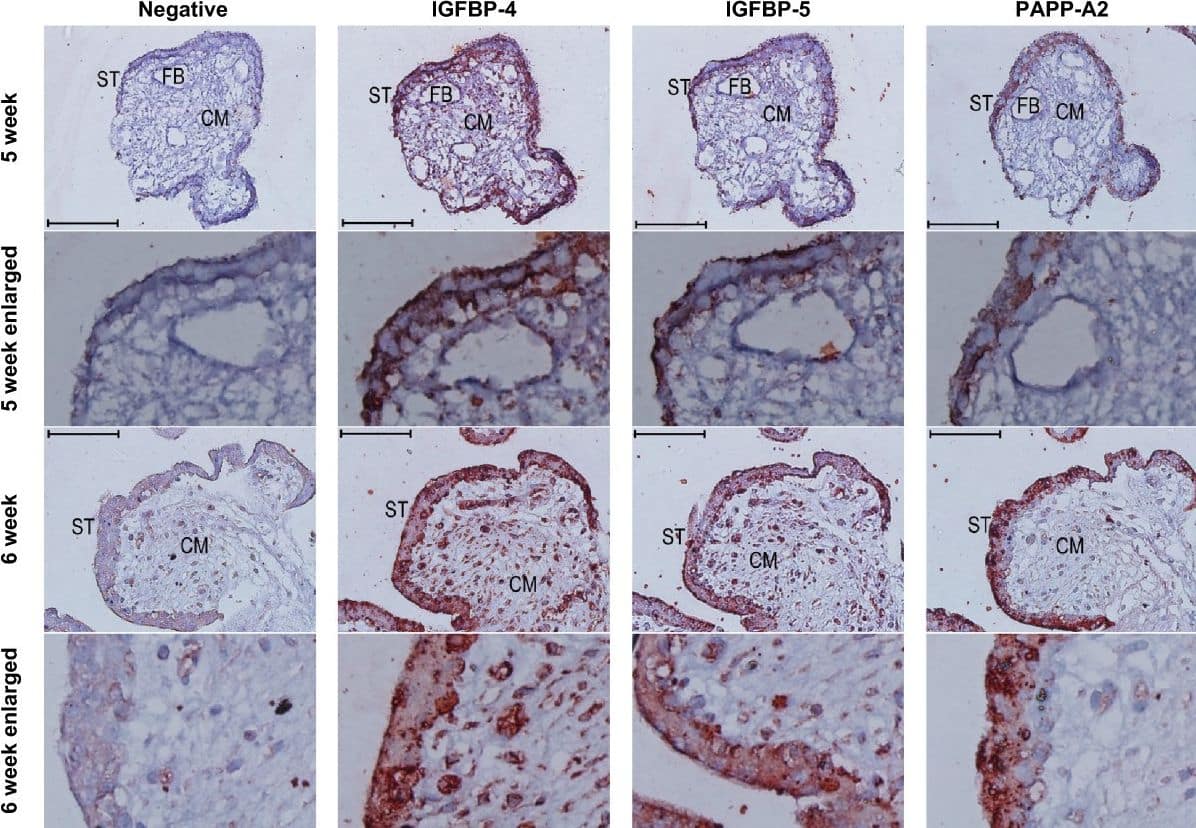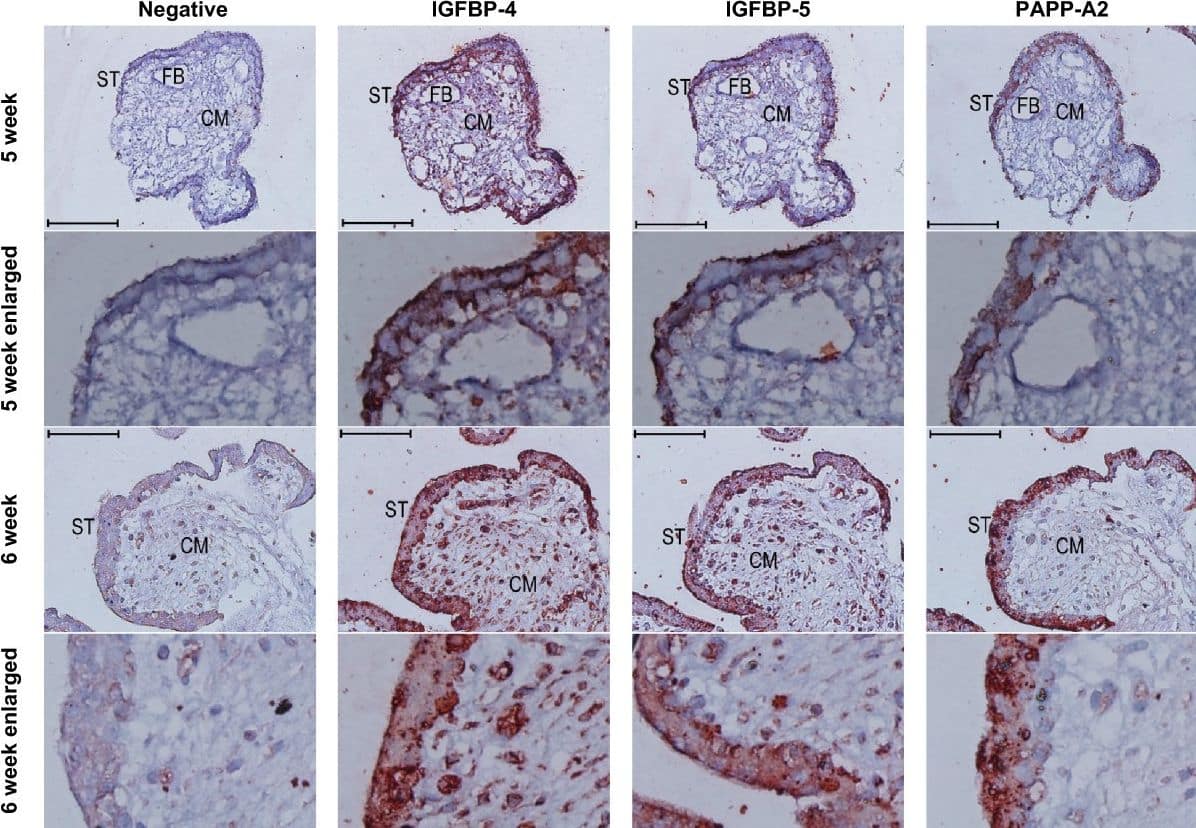Human IGFBP-4 Antibody
R&D Systems, part of Bio-Techne | Catalog # AF804


Key Product Details
Species Reactivity
Validated:
Cited:
Applications
Validated:
Cited:
Label
Antibody Source
Product Specifications
Immunogen
Asp22-Glu258
Accession # AAA62670
Specificity
Clonality
Host
Isotype
Endotoxin Level
Scientific Data Images for Human IGFBP-4 Antibody
IGFBP‑4 in Human Placenta.
IGFBP-4 was detected in immersion fixed paraffin-embedded sections of human placenta (chorionic villi) using 5 µg/mL Goat Anti-Human IGFBP-4 Antigen Affinity-purified Polyclonal Antibody (Catalog # AF804) overnight at 4 °C. Before incubation with the primary antibody tissue was subjected to heat-induced epitope retrieval using Antigen Retrieval Reagent-Basic (Catalog # CTS013). Tissue was stained with the Anti-Goat HRP-AEC Cell & Tissue Staining Kit (red; Catalog # CTS009) and counterstained with hematoxylin (blue). View our protocol for Chromogenic IHC Staining of Paraffin-embedded Tissue Sections.IGFBP‑4 Inhibition of IGF‑II-dependent Cell Proliferation and Neutralization by Human IGFBP‑4 Antibody.
Recombinant Human IGFBP-4 (Catalog # 804-GB) inhibits Recombinant Human IGF-II (Catalog # 292-G2) induced proliferation in the MCF-7 human breast cancer cell line in a dose-dependent manner (orange line). Inhibition of Recombinant Human IGF-II (14 ng/mL) activity elicited by Recombinant Human IGFBP-4 (0.3 µg/mL) is neutralized (green line) by increasing concentrations of Goat Anti-Human IGFBP-4 Antigen Affinity-purified Polyclonal Antibody (Catalog # AF804). The ND50 is typically 12-60 µg/mL.Detection of Human IGFBP-4 by Immunohistochemistry
Immunoreactivity (red colour) against IGFBP-4, −5, and PAPPA2 in the syncytiotrophoblast of first trimester placental villi. Serial cross sections of placental villi at 5 and 6 weeks of gestation (7 and 13 weeks not shown) were stained for IGFBP-4, IGFBP-5, and PAPP-A2. Negative controls used non-specific goat IgG in the place of the primary antibodies. FB = fetal blood vessel, CM = chorionic mesoderm, ST = syncytiotrophoblast. Scale bars denote 100 μm. Image collected and cropped by CiteAb from the following open publication (https://pubmed.ncbi.nlm.nih.gov/25475528), licensed under a CC-BY license. Not internally tested by R&D Systems.Applications for Human IGFBP-4 Antibody
Immunohistochemistry
Sample: Immersion fixed paraffin-embedded sections of human placenta (chorionic villi) subjected to Antigen Retrieval Reagent-Basic (Catalog # CTS013)
Western Blot
Sample: Recombinant Human IGFBP-4 (Catalog # 804-GB)
Neutralization
Reviewed Applications
Read 1 review rated 3 using AF804 in the following applications:
Formulation, Preparation, and Storage
Purification
Reconstitution
Formulation
Shipping
Stability & Storage
- 12 months from date of receipt, -20 to -70 °C as supplied.
- 1 month, 2 to 8 °C under sterile conditions after reconstitution.
- 6 months, -20 to -70 °C under sterile conditions after reconstitution.
Background: IGFBP-4
Human IGF binding protein 4 (IGFBP-4) was isolated from human plasma based on its ability to bind immobilized IGF-I. Human IGFBP-4 cDNA encodes a 258 amino acid (aa) residue precursor protein with a predicted 21 aa residue signal peptide that is processed to generate the 237 aa residue mature human IGFBP-4. The human IGFBP-4 contains a potential N-linked glycosylation site and shares approximately 90% amino acid sequence identity with both the mouse and rat IGFBP-4.
According to the nomenclature of IGFBPs defined at the 4th International Symposium of IGFs (1997, Tokyo), six high-affinity IGF binding proteins
(IGFBP-1, -2, -3, ‑4, ‑5, ‑6), and four IGFBP-related proteins (IGFBPr-1, - 2, -3, -4) have been identified. All IGFBPs have a high cysteine content and share conserved cysteine residues that are clustered in the amino- and carboxy-terminal third of the molecule. IGFBPs have been shown to either inhibit or enhance the biological activities of IGF, or act in an IGF-independent manner. Post-translational modification of IGFBPs, including phosphorylation and proteolysis, have been shown to modify the affinities of the binding proteins for IGF and may indirectly regulate IGF actions.
References
- Jones, J. I. and D.R. Clemons (1995) Endocrine Rev. 16:3.
- Kelly, K.M. et al. (1996) Intl. J. Biochem. Cell Biol. 28:619.
- Kim, H-S. et al. (1997) Proc. Natl. Acad. Sci. USA 94:12981.
Long Name
Alternate Names
Gene Symbol
UniProt
Additional IGFBP-4 Products
Product Documents for Human IGFBP-4 Antibody
Product Specific Notices for Human IGFBP-4 Antibody
For research use only


